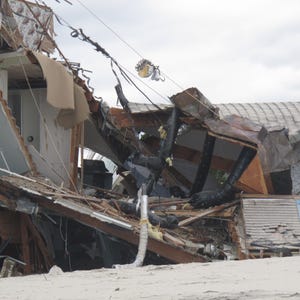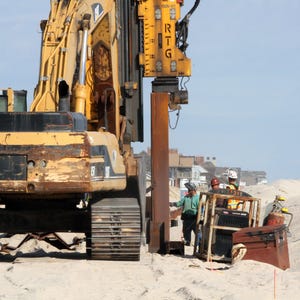Come Sunday, 1,000 days will have passed since Superstorm Sandy began her rampage across the Jersey Shore. Thousands of New Jersey families are still displaced. The state has been unable to match the pace of spending that Louisiana set in order to get its residents back in their homes after Hurricane Katrina in 2005. New Jersey has spent nearly $1.2 billion to rebuild or repair homes since the Oct.29-30, 2012 storm, or less than 20 percent of what Louisiana distributed in the same amount of time after Katrina, according to the latest figures filed by both states to the U.S. Department of Housing and Urban Development. Rebuilding government and economic infrastructure has proceeded much faster. Nearly $2.4 billion has been spent to restore damaged railways, roads, marinas, water centers, town halls and boardwalks.
Those improvements are of little comfort to the thousands of Shore residents forced to move from rental home to rental home because of bottlenecks in the reconstruction process hampered by sluggish government agencies and programs.
Although more than 1,300 homes have been rebuilt through the state’s flagship rebuilding program, less than half of those have been elevated. Just 64 — out of 15,100 homeowners that originally sought help — are finished.
“A lot of people are hung up in the air,” said George Kasimos, one of the founders of the Sandy advocacy group Stop FEMA Now.
“I feel like we’ve been abandoned”
Little Egg Harbor residents Ralph and Amalia DeNisco just want to go back home.
The retired couple moved out of their 1,300-square-foot, lagoon-front home in September so a contractor could elevate the house. They expected to be back by January.
Six months later, the house remains unfinished, perched on wooden cribbing with missing floors that have left the interior open to both winter storms and summer heat. The DeNiscos remain stuck: They’re renting a room from a neighbor and their possessions, including furniture, flooring and flat-screen TVs, remain crammed into two metal containers on their block. One container sits on their lot while another is across the street, where a neighbor had given permission for it to be temporarily stored.
There is no reliable estimate of the number of New Jersey residents still displaced. But its clearly in the thousands.
“I’m tired about people asking what’s happening with the house. What are you doing? Why don’t you sue them? All I want is for the guy to come and finish,” said Amalia DeNisco, 66, her voice cracking. “ I feel like we’ve been abandoned.”
Progress slow in RREM program
Sandy damaged or destroyed nearly 90,000 housing units in New Jersey, while Hurricane Katrina destroyed 200,000 Louisiana homes.
Yet at the same point in the recovery process, Louisiana’s signature recovery program was spending virtually all of the housing aid as it was coming in from the feds, but New Jersey has been more deliberate. There was nearly $96 million in RREM budgeted funds available to New Jersey that had not been released by the end of March, according to HUD reports.
Nearly 7,200 homes in New Jersey’s largest rebuilding program for homeowners, the Reconstruction, Rehabilitation, Elevation and Mitigation (RREM) program, are in construction or ready to start, but just 64 homes are all the way out of the program, according to the state Department of Community Affairs.
Presidential candidate and Gov. Chris Christie — as he has often done before — pointed to government red tape as the culprit.
“It’s extraordinarily difficult as you make your way through the federal-state maze of challenges … to get that done as quickly as you possibly can,” he said in Spring Lake Thursday as he announced federal funding for a flood mitigation project.
There are several choke points in the rebuilding process, but one in particular is home elevation.
By the end of March, fewer than 500 homes had been elevated through RREM or its sister program for low- and moderate-income homeowners. All 9,200 homes in those programs must be elevated, and then pass final inspections, before they are finished with the program. There is no estimate when all the houses will be elevated, but the RREM grants will expire Oct. 29, 2016, four years to the day after the storm hit the Shore.
Not enough home lifters
On January 13, Greg Durgin, 52, moved out of his home in the Loveladies section of Long Beach Township so that his house could be elevated. He thought that was the beginning of his return home, but it wasn’t the beginning of anything: No work started for four months.
Durgin said he later learned that his RREM-assigned contractor had not applied for building permits until late April.
“This is definitely the worse and most stressful thing I have ever been through,” he said.
Kasimos, the Stop FEMA Now co-founder, said many people’s homes have been lifted but remained unfinished.
“Contractors need money to keep working,” said Kasimos, of Toms River. “RREM is paying 120 to 180 days late.”
Four to six weeks is the normal turnaround for payment requests, said Lisa Ryan, a spokeswoman for the New Jersey Department of Community Affairs.
There are 53 active registered home-elevation contractors in the state, according to the New Jersey Department of Consumer Affairs.
Not all of those are equally capable, says Jason Yarusi, vice president of W.A. Building Movers, a family-owned company out of Westfield that has been lifting homes since 1970. He estimates that just 13 contractors in the state who actually have the experience the state requires.
That’s only part of the reason why progress has been so slow, Yarusi said. With so many schedules and variables to juggle — permits from individual towns, utilities, other contractors, when grant money gets released — it’s difficult to project when work will actually get done.
Problems beyond troubled state programs
Those not in the RREM program, like the DeNiscos, are also struggling.
After the DeNiscos’ house was flooded with about three feet of water during Sandy, the couple repaired their home and replaced water-logged furniture and appliances using $60,000 in flood insurance proceeds and a Small Business Association loan.
Last year they decided to elevate the house to protect it against future storms and also lower their flood insurance payments. By the time the couple decided to lift their home, RREM was no longer accepting applications.
They instead are relying on $30,000 in federal mitigation funds available for homeowners who had flood insurance at the time of the storm, and an additional $30,000 from the state’s Hazard Mitigation Grant Program.
In June, they signed a contract with Little Egg Harbor-based RCMS to lift their house and install pilings that would elevate it to 9 feet. Company owner Jeff Colmyer also agreed to re-install their laminate flooring and replace landscaping on the property. The DeNiscos said Colmyer told them they would have to leave their house in early September, but promised they’d be home by the holidays.
“We figured it would be the end of January, because there could be bad weather,” said Ralph DeNisco, 67. They moved across the street into the house of their neighbors and good friends. The neighbors spend winters in Florida, and the DeNiscos thought they’d be able to move back home before their neighbors returned.
Permits and paperwork
The lift of their three-bedroom, two-bath home began on Oct. 16. The DeNiscos said they paid RCMS $10,000 on June 20, when they first signed the contract, and $5,000 more in November.
The delays began early on, they said. The DeNiscos carefully documented every bit of work done on the property, creating a detailed timeline that’s filled with gaps in which RCMS did no work at all.
RCMS owner Jeff Colmyer said that it took Little Egg Harbor government six months to issue a building permit for the property, which accounts for most of the delay. Additionally, the township’s zoning office rejected the initial plans for the house on Jan. 28, noting that the rear stairs were too close to the lagoon because of a previous addition to the home. That required him to resubmit a zoning application for the project, which took more time.
Colmyer said he was eager to help the DeNiscos get back into their home faster, so after filing all the required paperwork, he began working on the house before receiving the permit. The township fined him $2,000 and ordered him to stop work on the project until the permit was received, Colmyer said.
“I don’t take on jobs because I’m trying to get over on anybody,” Colmyer said. He said his company is working on about 60 projects and “I’m tight for cash.” So far he has only received $15,000 for the work at the DeNiscos, he said.
Running in place
From Jan. 13 to April 15, no work was done. By April 3, Amalia DeNisco had begun to panic. Her neighbors would soon be back and the house was not close to completion.
“Very little has been done,” Ralph DeNisco said. “We’re still at least three to four months away from completion.” The couple has continued to pay $1,200 monthly in mortgage and flood insurance payments on the house. They’re also paying rent to their neighbors.
Frustrated, the DeNiscos filed a complaint against RCMS with Ocean County Consumer Affairs, one of two filed with the county against the company, according to Stephen Scaturro, consumer affairs director. “We just want him to come back and finish the work,” Amalia DeNisco said.
The state Department of Consumer Affairs has taken over the investigation into the complaints. Spokesman Jeff Lamm said a third complaint has been filed with the state against RCMS. “They are open, and they will be reviewed,” Lamm said. “Other than that, I am not allowed to discuss anything about pending complaints.”
“It won’t help us,” Ralph DeNisco said of the couple’s reason for filing a complaint. “But it might help someone else.”
Colmyer said he is meeting with the DeNiscos early next week to discuss what needs to be done to complete the project and get them back home.
Slowing the process
Sue Marticek, executive director of the Ocean County Long-Term Recovery Group, said of the 500 RREM projects the group is helping to get through the process, about one in eight have had some kind of dispute with a contractor.
“On a short-term level, we really need to put a watchful eye on the contractors,” Marticek said. But she also criticized the slow pace of payments in the program, noting that’s making it difficult for legitimate contractors to move forward with projects.
Vincent Simonelli, a builder who owns Dream Homes in Lacey, said contractors working in the state’s rebuilding programs must be prepared to wait weeks for payment and have the financial means to do so.
“The state cuts checks once a month,” said Simonelli, who estimated his company is working on or has completed about 100 RREM projects. “If you forget to sign even one line, they will send the paperwork back to you and you won’t get paid.” He estimated his firm is owed $300,000 to $400,000 for completed RREM project work.
He said that while the RREM program has streamlined the process, it’s still slow going.
Yarusi, the house lifter, remains optimistic that circumstances are changing.
“Ultimately, I see a lot of people getting back in their homes now,” he said. “I was recently on one street in Port Monmouth that we have raised four homes on and almost the whole street has been raised and the homes are looking great and hopefully much more of this will follow.”



